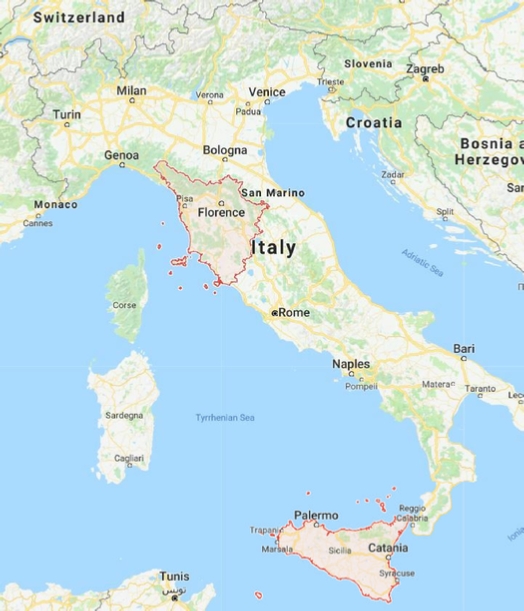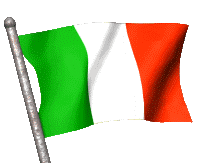
So many countries, so little time. I have journeyed to many places in my life, but never to one where English is not the dominant language. However, my next excursion is to the second of the two major birthplaces of Western Culture – Italy. (It is doubtful that the two years of Latin that I took 50+ years ago in high school will be of much use.) Our trip will begin in Rome from whence we will journey north for a week in Tuscany staying near the medieval city of Siena. Then we will fly to Catania in Sicily for three days. Finally, along with my friend, Sharon Campbell, we will drive from Sicily back up the boot to Rome passing Naples, Pompeii and Mount Vesuvius for a final day to take in the sights of Rome.
A Brief History of Italy
Extending from Southern Europe into the Mediterranean Sea, Italy is strategically located to dominate the region. It has used this to its advantage throughout history.
The Roman Empire was founded in Rome around 27 BC. For approximately 1500 years, Rome (and later Byzantium) ruled major portions of Europe, the Middle East and North Africa. At its peak circa 100 AD, the Pax Romanum (the Roman Peace) stretched from ancient Babylonia, through Ægyptus, Hispania, Britannia and Gallia. The Empire was so influential that with the fall of the Western Roman Empire in the 5th century, Europe plunged into a Dark Ages that would last for a thousand years.
Britannia and Gallia. The Empire was so influential that with the fall of the Western Roman Empire in the 5th century, Europe plunged into a Dark Ages that would last for a thousand years.
The Renaissance (or Rebirth) of Western Civilization began as the Dark Ages waned. Starting in Florence in the 14th century with the writings of Dante Alighieri and Petrarch, as well as the paintings of Giotto di Bondone, it sparked a two millennium growth throughout Europe in art, architecture and science that led to the world as we know it today.
Tuscany
Florence, the capital and heart of Tuscany, is located about 140 miles north of Rome. As the birthplace of the Renaissance, it is replete with art and science. Among the historical figures that claim Florence as their birthplace are Leonardo da Vinci, considered THE “Renaissance Man”, Michaelangelo, Dante, Petrarch and, of course, the Medicis.
Tuscany covers almost 9,000 square miles and is home to almost 4 million people. One of its primary products is wine, especially Chianti. That’s the wine that you usually see encased in a wicker basket. A pasta dish without Chianti is like Aunt Jemima’s pancakes without her syrup!
In the heart of Tuscany lies the Etruscan city of Siena. Its historic center has been declared by UNESCO a World Heritage Site. It is famous for its art, museums, cuisine and its medieval cityscape.
Seven miles west of Siena’s Piazza del Campo is our residence for the first week of our stay – the Casale Il Colombaio di Toiano. It is described as “…an old colonic stone house situated in one of the most enchanting regions [known] for its historical, artistic and cultural richness”. Following our week in Tuscany, I, along with my friends Sharon Campbell and Pam and Merv Forney, will journeys south to the largest Island in the Mediterannean Sea - Sicily.
Sicily
At the toe of the Italian boot, the island of Sicily lies 5 miles across the Strait of Messina. Dominated by Mount Etna, the tallest active volcano in Europe standing at 10,922 feet, it has been a home of humanity for over 14,000 years. It has seen colonies from Phoenicia and Greece and has been invaded by the Carthaginians, Romans, Arabs, Germanic tribes and Spain and was even influenced by the Normans.
Sicily became a part of Italy in 1860 and was given the status of an autonomous state in 1946. As a crossroads of the Mediterranean, Sicily has had a major influence on art, architecture, science and cuisine. One if its most famous citizens was the mathematician Archimedes who, in 213 BC, was instrumental in repulsing the Romans.
Given the impact of the many countries that have influenced this small island, its cuisine is so varied that it has been referred to as God’s Kitchen. While it is rich in its varieties of pasta, Sicily is best known for its rich sweet dishes, the king of these being the Cannoli.
The Flews and the Tuscan Connection
Oddly enough, I have recently discovered that the Flews might have a connection to Tuscany. Cissy received an email from a woman suggesting that my grandfather on my mother’s side might have actually been a man from Chicago named Pisano. She was living in Chicago at the right time and in the right neighborhood. And, according to our Ancestry DNA tests, we are about 10% Southern European which is predominantly Italy. A quick Google search returns the meaning of the surname Pisano as “a person from Pisa”. Pisa (home of the Leaning Tower) is a prominent town in northwest Tuscany. So this trip could be the third leg of my search for my roots.
To follow our journey, you can start by clicking the link below.
Extending from Southern Europe into the Mediterranean Sea, Italy is strategically located to dominate the region. It has used this to its advantage throughout history.
The Roman Empire was founded in Rome around 27 BC. For approximately 1500 years, Rome (and later Byzantium) ruled major portions of Europe, the Middle East and North Africa. At its peak circa 100 AD, the Pax Romanum (the Roman Peace) stretched from ancient Babylonia, through Ægyptus, Hispania,
The Renaissance (or Rebirth) of Western Civilization began as the Dark Ages waned. Starting in Florence in the 14th century with the writings of Dante Alighieri and Petrarch, as well as the paintings of Giotto di Bondone, it sparked a two millennium growth throughout Europe in art, architecture and science that led to the world as we know it today.
Florence, the capital and heart of Tuscany, is located about 140 miles north of Rome. As the birthplace of the Renaissance, it is replete with art and science. Among the historical figures that claim Florence as their birthplace are Leonardo da Vinci, considered THE “Renaissance Man”, Michaelangelo, Dante, Petrarch and, of course, the Medicis.
Tuscany covers almost 9,000 square miles and is home to almost 4 million people. One of its primary products is wine, especially Chianti. That’s the wine that you usually see encased in a wicker basket. A pasta dish without Chianti is like Aunt Jemima’s pancakes without her syrup!
In the heart of Tuscany lies the Etruscan city of Siena. Its historic center has been declared by UNESCO a World Heritage Site. It is famous for its art, museums, cuisine and its medieval cityscape.
Seven miles west of Siena’s Piazza del Campo is our residence for the first week of our stay – the Casale Il Colombaio di Toiano. It is described as “…an old colonic stone house situated in one of the most enchanting regions [known] for its historical, artistic and cultural richness”. Following our week in Tuscany, I, along with my friends Sharon Campbell and Pam and Merv Forney, will journeys south to the largest Island in the Mediterannean Sea -
At the toe of the Italian boot, the island of Sicily lies 5 miles across the Strait of Messina. Dominated by Mount Etna, the tallest active volcano in Europe standing at 10,922 feet, it has been a home of humanity for over 14,000 years. It has seen colonies from Phoenicia and Greece and has been invaded by the Carthaginians, Romans, Arabs, Germanic tribes and Spain and was even influenced by the Normans.
Sicily became a part of Italy in 1860 and was given the status of an autonomous state in 1946. As a crossroads of the Mediterranean, Sicily has had a major influence on art, architecture, science and cuisine. One if its most famous citizens was the mathematician Archimedes who, in 213 BC, was instrumental in repulsing the Romans.
Given the impact of the many countries that have influenced this small island, its cuisine is so varied that it has been referred to as God’s Kitchen. While it is rich in its varieties of pasta, Sicily is best known for its rich sweet dishes, the king of these being the Cannoli.
Oddly enough, I have recently discovered that the Flews might have a connection to Tuscany. Cissy received an email from a woman suggesting that my grandfather on my mother’s side might have actually been a man from Chicago named Pisano. She was living in Chicago at the right time and in the right neighborhood. And, according to our Ancestry DNA tests, we are about 10% Southern European which is predominantly Italy. A quick Google search returns the meaning of the surname Pisano as “a person from Pisa”. Pisa (home of the Leaning Tower) is a prominent town in northwest Tuscany. So this trip could be the third leg of my search for my roots.
To follow our journey, you can start by clicking the link below.


